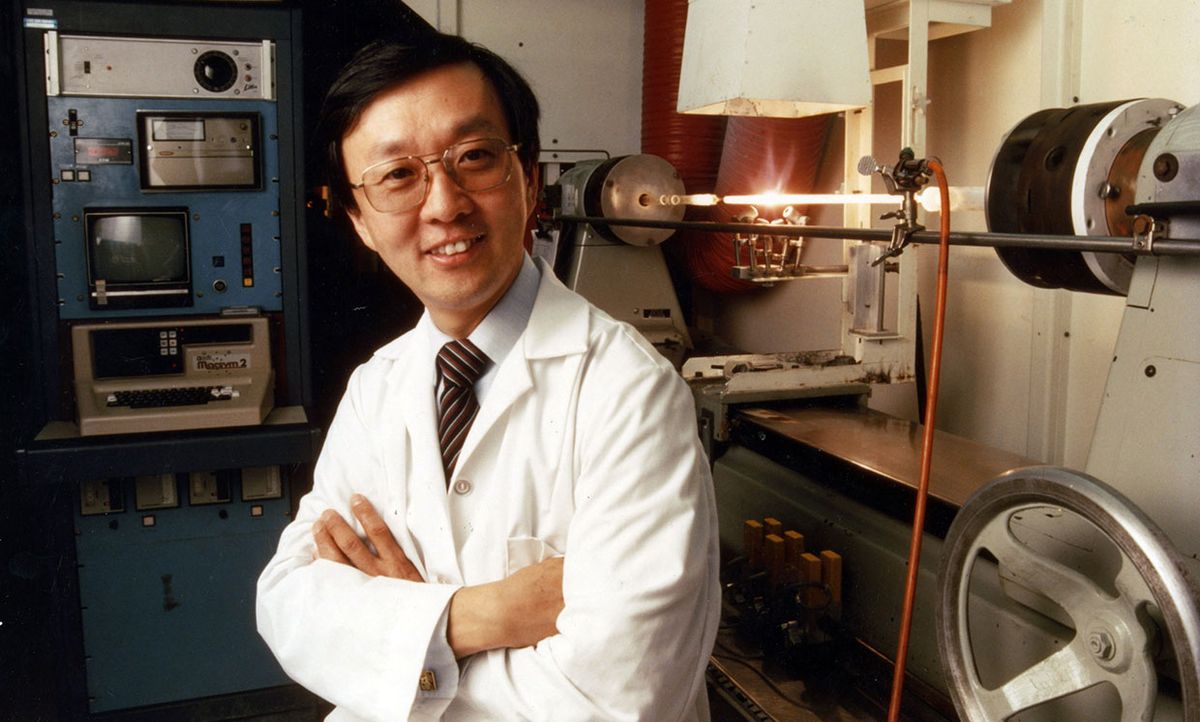Nobel laureate Charles Kao was a visionary. He saw the possibilities of fiber-optic communications early, and made it happen before its time.
Charles Kuen Kao, the engineer who received the 2009 Nobel Prize in Physics for pioneering work in fiber-optic communications, died on 23 September in Hong Kong at age 84. His work opened the way to the huge transmission capacity of modern telecommunications, which, combined with the signal processing of integrated electronics, powers our information society.
Kao was working at Standard Telecommunications Laboratories in Harlow, Essex, in England, when the laser was invented in 1960. The cutting edge of telecommunications research then was the millimeter waveguide, a hollow 5-centimeter metal tube designed to transmit 60-gigahertz millimeter waves. This offered higher bandwidth than chains of microwave relay towers, but the waves could travel only short distances in the open air. Laser light offered even higher bandwidth because its frequencies were much higher, so engineers at STL and other labs began testing laser communications. However, the initial results were discouraging; weather interfered with open-air transmission, and hollow optical waveguides had to meet extremely demanding requirements beyond the budgets of anyone but Bell Labs.
STL saw little potential market for millimeter waveguides because British transmission lines were too short and winding to use them, but Alec Harley Reeves, the inventor of pulse-code modulation, had a little group study prospects for laser communications. Eventually Antoni E. Karbowiak, the group manager, decided that the only media usable for transmitting laser communications were optical fibers, which had the flexibility needed for the British phone network. Then he accepted a professorship in Australia, leaving Kao, not yet 30, in charge.
Kao and George Hockham calculated that fibers could be modulated to transmit signals spanning a gigahertz of bandwidth over the required distance if the glass could be made transparent enough. At the time, the best optical glasses on the market could carry light only about 10 meters. However, Harold Rawson, a glass expert at the University of Sheffield, told Kao that purifying glass would make it transparent enough to carry laser signals 10 kilometers or more between telephone switching centers.
That would require a factor of a thousand improvement—a jump that seemed outlandish to many observers. To show that it would be possible, Kao enlisted the help of Mervin W. Jones to measure the transparency of the purest known glass, called fused silica, which had been invented by the Corning Glass Works in the 1930s and valued at the time for its low thermal expansion. Its absorption was so low that it took them months to get a solid result. In 1969 the duo reported a stunningly low attenuation of no more than 5 decibels per kilometer, several times clearer than Kao had thought necessary.
By then, Corning was hard at work converting fused silica into optical fibers, and in 1970, Robert Maurer of Corning reported making optical fibers with a loss of 17 decibels per kilometer, confirmed by measurements in other labs. Within a couple of years Maurer, Donald Keck, Peter Schultz, and Frank Zimar of Corning reduced that to just 2 decibels per kilometer. Today the clearest glass has a loss of only about 0.15 decibel per kilometer, close to the theoretical limit.
Kao's proposal and measurements, and Corning's low-loss fiber, converted the skeptics. Soon Bell Labs launched projects to develop long-lived semiconductor diode lasers and connectors for fiber-optic communication systems. Others soon joined the race. In 1977 GTE was the first to send live telephone traffic through optical fibers in the phone network, followed within weeks by AT&T. By then, the millimeter waveguide was dead, and in the 1980s fiber-optic networks spread around the world. Since then, the data rate that can be transmitted through a single optical fiber has increased at Moore's Law rates as integrated circuit performance has improved.
Combining the tremendous bandwidth of fiber optics with the tremendous processing power of electronics has brought about a technological revolution.
Looking back, the invention of integrated electronics seems almost preordained because the advantage of integration was obvious. Jack Kilby and Robert Noyce deserve the recognition they have received, but had they not succeeded, someone else would have come along. Charles Kao was ahead of his time. He invented fiber-optic communications when the conventional wisdom was that solids were too lossy to carry signals over long distances. Had Kao not recognized the potential of glass, or not been able to tap the technology Corning had developed for other purposes, it likely would have been years before someone else could have put the pieces together to make today's high-performance Internet.
A correction to this article was made on 27 September 2018.
Jeff Hecht writes about lasers, optics, fiber optics, electronics, and communications. Trained in engineering and a life senior member of IEEE, he enjoys figuring out how laser, optical, and electronic systems work and explaining their applications and challenges. At the moment, he’s exploring the challenges of integrating lidars, cameras, and other sensing systems with artificial intelligence in self-driving cars. He has chronicled the histories of laser weapons and fiber-optic communications and written tutorial books on lasers and fiber optics.



